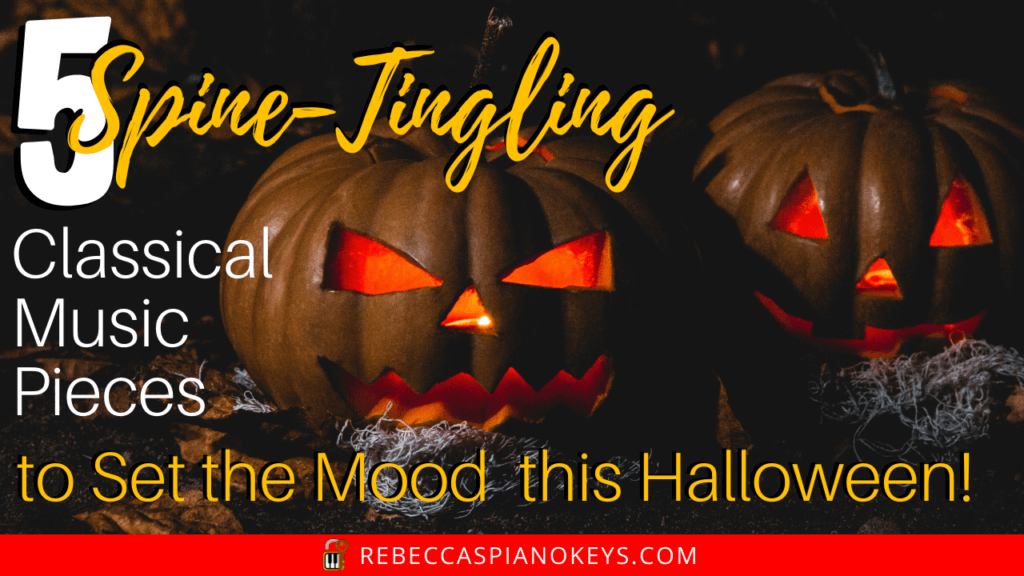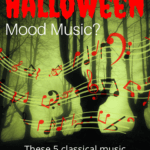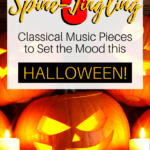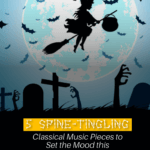Last Updated on July 10, 2022 by Rebecca
Disclosure: Please note that this article contains affiliate links, and that means that I may earn a commission if you buy something through my links. Read my full disclaimer here.
What better way to create a creepy Halloween atmosphere than to play some scary classical music? Talk about creating a haunted house vibe!
Now, I know I usually focus specifically on piano, but today I decided to branch out and include any kind of classical pieces. Most of them are orchestral, but in one case I included a piano version. These pieces will provide perfect background music for your Halloween party, or for greeting trick-or-treaters at your door.
And they are also treasure troves of inspiration for your own spooky Halloween piano improvisations! Listen to them with an ear for what makes them sound so deliciously terrifying!
Pay attention to how they use each of the following musical elements to create a feeling of dread:
- dynamics
- tempo
- pitch
- harmony
- articulation
- rests
Don't have time to listen right now? Pin this post for later and come back with some popcorn and your best headphones! (Bonus points if you come back late at night and curl up in a dark room to listen to these perfect-for-Halloween pieces!)

1. La Danse macabre (Camille Saint-Saens)
This is a fantastically spooky piece of music, full of big dramatic sound!
The Story Behind the Piece
In her article Saint-Saens and his Danse Macabre for Halloween, Cynthia Collins explains that this piece is “based on a French legend about Death appearing every Halloween at midnight. As he plays his fiddle, the skeletons rise from their graves and dance until dawn, returning to their graves when the rooster crows.” Can you picture the scene as you listen to the music?
My Personal Favourite Touches
- The 12 opening notes of the piece.
I used to think the opening of La Danse macabre was boring — just a slow quiet bit to be tolerated until the real music started. Then I read an article on ClassicFM that explains: “There's a whole narrative that unfolds in the piece, with the violin representing death himself and the story starting at midnight — hence the twelve chiming opening notes.” I had never even noticed there were 12 notes in the opening, let alone that they were the same note repeated 12 times, to mimic the sound of a clock chiming midnight! Now this is one of my favourite bits of the whole piece. (I love when music gets clever!) - The sawing violin tritones in the opening.
This bit is meant to represent the appearance of Death at the beginning of the piece, which is an incredibly effective melding of music and imagery. And there's nothing I love more than a piece of music that vividly tells a story.
But the truth is, even without the story, I just plain love listening to this bit. I'm not sure what it is, but I love the scratchy sawing of a violin. I love how raw and undelicate it sounds. Which is ironic, since violinists dedicate an awful lot of practice to avoiding scratches!
I guess this is one of those instances where you learn the rules so you'll know how to break them. There's nothing pleasing to the ear about a bunch of accidental and uncontrolled violin scratches… but deliberate scratches done by skilled violinists are just plain magical in my opinion. - The repeated descending violin lines that start at 5:45. I wish I could explain why I love these so much, but I just can't find words. I just know that I delight in listening to them!
A Bit About the Composer
Cynthia Collins writes that “Saint-Saens (1835-1921) was born in Paris and started piano lessons before he was three years old and began formal training in composition at the age of seven.” If you've been following me and my blog for a while, you'll already know why I love this so much! He was learning composing, not just how to play other people's music!
Some other pieces Saint-Saens is famous for include The Carnival of the Animals, which included the famous movement Le cygne (The Swan).

2. A Night on the Bare Mountain (Modest Mussorgsky/Nikolay Rimsky-Koraskov)
In researching this piece, I've discovered there's a lot of discrepancy on the internet as to its actual title. Some websites call it “A Night on Bald Mountain” and others call it “A Night on the Bare Mountain.” I'm assuming this is a result of different translations from the original Russian title of the piece. From what I can tell, it's a tomayto/tomahto situation.
To me, it will always be “The Scary Song from Disney's Fantasia.”
The Story Behind the Piece
An article from the BBC “Ten Pieces” series explains: “A Night On The Bare Mountain describes a short story in which St John sees a witches' Sabbath on the Bald Mountain near Liev in the old Russian Empire. It's a wild and terrifying party with lots of dancing but when the church bell chimes 6am and the sun comes up the witches vanish.”
The scene depicted in Disney's Fantasia is different, with souls being summoned by an evil demon and floating around through the air.
So what do you envision when you listen to this piece?
My Personal Favourite Touches
- The panicky opening.
I love how completely panicked the opening sounds. It really sets you up to anticipate something bad about to happen. - The dramatic “evil” horns following the opening.
For one thing, I just love how dramatic this bit sounds. But there's also something really satisfying in the way it fits the story arch. The big, bad, loud, deep horns form the culmination of the panicky opening and give us the satisfaction of thinking:”See? I was right! I knew something bad was going to happen!” - The repetition.
I'm a sucker for a catchy motif that keeps coming back for more. That “panicky opening followed by dramatic evil horns” motif comes back repeatedly throughout the piece, and it works its way deeper into my heart each time!
A Bit About the Composer
Modest Mussorgsky had a bit of a follow-through problem. A lot of his grand musical ideas never quite made it to completion. As ClassicFM explains:
In later life, [Mussorgksy's] failure to see ideas through to conclusion was sadly due to his alcoholism; in his youth it was mere exuberance and naive optimism, which could never quite be translated into reality.
– ClassicFM
In fact, we might not even know this piece at all today if it weren't for Nikolay Rimsky-Korsakov, who “produced his own re-orchestrated version (five years after Mussorgsky's death)” (Source: ClassicFM).

3. In the Hall of the Mountain King (Edvard Grieg)
The Story Behind the Piece
Classicsforkids.com provides an excellent PDF activity sheet that discusses the story behind Grieg's In the Hall of the Mountain King. (And since it's written for kids, it's really easy to understand!)
The short version is that this famous piece is one of several that Grieg composed for Henrik Ibsen's play, Peer Gynt. This piece was written to accompany “Peer Gynt's adventure in the underground Kingdom of the Trolls”(Source: Classicsforkids.com).
My Personal Favourite Touches
- The deep, dark, bass opening.
I love the drama created by the deep bass notes in the intro. This is one of the reasons I prefer the piano versions of this piece over the orchestral versions. Orchestral versions tend to give it a bit more of a light airy feel, but I love the dark drama created in the piano versions. - The steadily increasing tempo.
I love how the tempo slowly increases throughout the piece, building a feeling of anxiety in the listener.
A Bit About the Composer
Edvard Grieg (1843-1907) was a Norwegian composer. He had a “missionary zeal in promoting Norwegian composers and its music” and “After meeting with [Franz] Liszt in 1869, he returned to Norway and opened a Norwegian Academy of Music” (Source: Gramophone.co.uk) David Brensilver quotese Grieg himself, explaining:
[Grieg] wrote in the Romantic tradition with, in his own words, the determination to “create a national form of music, which could give Norwegian people an identity.”
– Source: David Brensilver, AllMusic.com
4. Toccata and Fugue in D Minor (Johann Sebastian Bach)
This is possibly one of the most famous pieces of spooky classical music. Which is funny, because once you get past the well-known intro, the rest of the piece is much less spooky! (In fact, if it weren't on an organ, it might sound downright cheerful!)
The Story Behind the Piece
Interestingly, “there are actually three pieces of organ music written by Bach with the same name!” (Source: ClassicFM.com) This one is his Toccata and Fugue in D minor, BWV 656. (It's the BWV number that helps to distinguish them.)
Even more interestingly, this piece may not have been written by Bach at all! In an article for WQXR.org, James Bennett II explains:
…there are several aspects of the piece that would have been unusual for organ works of that time and place. For starters, there are the parallel octaves of the opening (a compositional faux pas), the solo pedal statement of the fugal subject, and the conclusion of the work on a minor plagal (the “Amen”) cadence.
– James Bennett II (Source: WQXR.org)
This is the case with many famous Bach pieces. You'll often see pieces described as being “attributed to J. S. Bach.” He collected a lot of music, some his own compositions, and some transcriptions of works by others. And in some cases, it's unclear whether a particular piece is one of his own, or simply one from his collection.
My Personal Favourite Touches
- The dramatic opening. (Obviously!)
The dramatic opening of this piece is possibly one of the most famous pieces of classical music in the world. Everyone knows it! Even people who don't like classical music. And after the initial opening, this piece of music becomes disappointingly cheerful. It's really not the big, scary piece of music everyone thinks it is. - The descending line at 1:22.
This bit comes back a few times during the piece, and I love how it juxtaposes the higer-pitched bits that surround it.
A Bit About the Composer
An article from the British Library tells us that Johann Sebastian Bach (1685-1750) had a reputation “not as a composer, but as an astoundingly gifted organ player and improviser, and consultant for organ repair” (Source: British Library). Which, as you might guess, makes me really happy! I love musical improvisation!
In describing his music, the article from the British Library states:
Bach's style is baroque, characterised by lots of notes, simple motoric rhythms, and steady shifts of underlying harmony – it was derided by some as ‘sewing-machine music'. But he explored harmony much more deeply than other composers of the time: compared to say Handel or Vivaldi, Bach's music can contain extraordinarily ‘jazzy' chords and surprising dissonance, and will jump off to many different harmonic areas.
– Source: British Library
Regardless of what his reputation may have been in his lifetime, there is no doubt that he is now regarded as one of the most influential composers in Western music history.

5. Dance of the Knights (Sergey Prokofiev)
This is one of my favourite pieces, but it doesn't often get much attention when people make Halloween lists. I can never figure out why! It's so dramatic, ominous, and foreboding!
The Story Behind the Piece
This piece was written for Prokofiev's ballet “Romeo and Juliet.” Aaron Green explains: “It is meant to accompany the fateful encounter between the two warring clans of Shakespeare's romantic drama, then follow the action to the Capulets' masquerade ball, where Juliet encounters Romeo” (Source: LiveAbout.com).
My Personal Favourite Touches
- The dramatic intro. (Have you noticed I have a thing for dramatic musical intros?)
I love this intro bit when it opens the piece, and I love it every time it comes back later throughout the piece. It's just plain fantastic. It's so rich and full of drama! - The deep horns in the dramatic bits.
I love a deep horn bass line. Nothing else in music packs quite that level of ominousness, if you ask me. - The buttery smooth horns in the calm bits (ex: 1:45-2:30).
It's not all horns in this section, but you'll find some good examples in here of trumpets and French horns producing some wonderfully smooth, gentle music. - The magnificent crescendos (ex: 2:30-3:00).
Honestly, these moments when the music oh-so-gradually grows from its softest and most innocent to its heaviest and most menacing just absolutely make me melt. I love these parts! They are beautiful and so well executed!
A Bit About the Composer
Sergey Prokofiev (1891-1953) was a famous Russian composer. His “musical ambitions were fuelled by hearing his mother play Chopin and Beethoven on the piano in the evenings. Young Sergei composed his first piano piece at 5, and his first opera aged 9” (Source: ClassicFM). And as you can imagine, I'm absolutely thrilled that he was encouraged to create his own music right from the get go!
And believe it or not, Prokofiev actually has something in common with The Beatles: “At the end of June 1932, Prokofiev made a record for the first time in his life at London's famous Abbey Road studios”(Source: ClassicFM). Imagine that!
Related Spooky Halloween Music Posts:
Want to create your own spooky Halloween music for piano? I have a 3-part videos tutorial series to help!
- This video tutorial is for the absolute beginner who wants to create a spooky piano improvisation.
- This one is a spooky piano tutorial for the more experienced piano player who feels nervous about improvising.
- And this one is for pianists of all levels who want to add some extra variety to their spooky piano improvisations.
Share Your Thoughts About these Scary Classical Music Pieces!
Which piece is your favourite? And why do you love it? Are any of these pieces new discoveries for you? Share your thoughts in the comments!
And use these share buttons to send some scary Halloween music to a friend!





As a musician myself, I loved reading this! It’s fun to consider more than just the usual ‘Halloween music’.
Hi Britt, Thanks for stopping by! I’m glad you enjoyed my list! 🙂 What are some examples of the “usual Halloween music” you’re familiar with?
LOL, I learned In the Hall of the Mountain King in High School – brings back memories 😉 Good Choices!
Hi Kerry, Glad you enjoyed the list! I never learned In the Hall of the Mountain King, but it’s one I always enjoy listening to. Maybe I should learn it some day!
What a fun and interesting post! My kids and I loved the music choices and the information that you gave. I used it as part of their school work today (we homeschool) and I learned right along with them. Thanks for making our day a little bit more fun 🙂
Hi Amy, That’s fantastic that you were able to work it into your homeschooling! 🙂 Did the kids have any favourite pieces from the list?